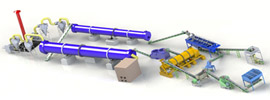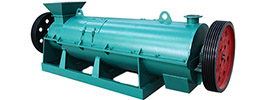The flat die feed pellet production line is a complete system for processing powdered feed raw materials (such as corn, soybean meal, straw, etc.) into pellet feed. Its process flow mainly includes four core stages: raw material pretreatment, batching and mixing, pelletizing and forming, post-processing, and packaging. Below are the specific processes and key control points:
I. Raw Material Pretreatment
- Raw Material Receiving and Cleaning
- Process: Raw materials (grains, straw, oilseed meals, etc.) enter the production line through the feeding port and pass through magnetic separation equipment to remove metal impurities (such as iron nails, stones) to prevent damage to subsequent equipment.
- Key Equipment: Magnetic separator, primary cleaner.
- Control Points: Regularly clean the magnetic separation equipment to avoid impurities entering the crusher.
- Crushing Process
- Process: Raw materials are processed by a crusher to achieve the target particle size, with a particle size distribution meeting the following requirements:
- ≤1% for particles above 3.35mm
- ≤5% for particles above 2.0mm
- Approximately 30% for particles above 0.5mm
- ≥20% for particles below 0.25mm.
- Purpose: Improve mixing uniformity and pellet forming rate.
- Equipment: Hammer mill (capable of processing coarse fibers such as straw).
II. Batching and Mixing
- Automatic Batching
- Process: The crushed raw materials are fed into a batching scale according to the formula ratio and accurately measured by a computer control system (error ≤0.1%) to ensure precise nutrient ratios.
- Equipment: Computerized batching scale, screw conveyor.
- Mixing and Conditioning
- Dry Mixing: Raw materials are uniformly stirred in a mixer (30-90 seconds per batch, with a mixing uniformity CV ≤5%).
- Liquid Addition: If oils or molasses need to be added, they are uniformly sprayed into the mixture during the mixing process via a spraying system.
III. Pelletizing and Forming
- Core Process of Flat Die Pelletizing
- Feeding: The mixed powder is uniformly fed into the pelletizing chamber of the flat die pellet mill via a screw feeder.
- Extrusion Forming:
- Conical rollers rotate against a horizontal flat die, pressing the material into die holes (hole diameter adjustable from 2–12mm).
- Friction generates high temperatures (up to 75°C), achieving raw material熟化 and sterilization without the need for additional water (dry-in, dry-out process).
- Pellet Cutting: The extruded strip feed is cut into pellets by a rotating cutter (length = 2–3 times the diameter, approximately 5–10mm).
- Key Parameters:
- Flat die speed: Approximately 60–366r/min (low speed reduces wear).
- Raw material moisture: 12–18% (excessively high moisture can cause blockages, while excessively low moisture affects forming).
IV. Post-Processing and Packaging
- Cooling
- Process: Freshly formed pellets, with high temperatures (approximately 70–80°C) and moisture content (≤20%), are cooled to room temperature (≤5°C above ambient temperature) using a counterflow cooler, which also extracts hot and humid air to prevent mildew.
- Screening
- Process: The cooled pellets are graded by a vibrating screen:
- Qualified pellets (with a powder content ≤5%) proceed to the packaging stage.
- Powder or broken pellets (with a return rate ≤10%) are returned to the mixing stage for repelletizing.
- Packaging and Palletizing
- Automatic Sewing: After filling, the pellets are sealed by a sewing machine (with stitches 3–4cm from the bag mouth, free of skipped stitches or breakages).
- Palletizing Standard: 10 layers × 6 bags per pallet, with labels facing outwards, and classified stacking with identification.
V. Key Process Parameters and Quality Control
| Process |
Key Parameters |
Control Range |
Importance Explanation |
| Crushing Size |
Proportion below 0.25mm |
≥20% |
Affects pellet forming rate |
| Pellet Length |
Length/diameter ratio |
2.0–3.0 times (5–10mm) |
Reduces powderization |
| Finished Product Powder Content |
Powder content after screening |
≤5% |
Ensures feed utilization rate |
VI. Production Line Advantages and Suitable Scenarios
- Advantages:
- Energy-efficient and Efficient: Simple flat die structure, low power consumption (30% lower than ring die mills), suitable for small and medium-sized farms.
- Flexible Adaptation: Replaceable flat die holes for producing pellets of different specifications (2–4mm for poultry feed, 6–8mm for cattle and sheep feed).
- Enhanced Feed Quality: Pellets with moderate hardness reduce animal selective feeding and improve digestibility by over 20%.
- Suitable Scenarios:
- Livestock and poultry farming (pigs, cattle, poultry), straw resource utilization.
Through the above process, the flat die feed production line achieves automated and standardized production from raw materials to pellets, balancing efficiency and quality. It is particularly suitable for small and medium-sized feed processing needs with an annual output of 500–5,000 tons.
 Send us a Email
Send us a Email Wulong Industrial Cluster
Wulong Industrial Cluster Have any question?
Have any question?


















